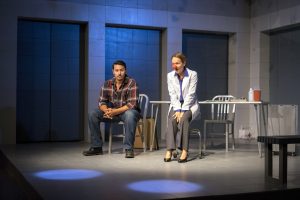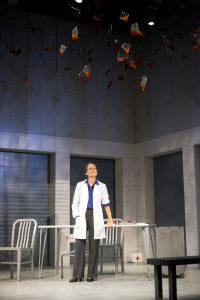‘Roz and Ray’ Uneasily Mixes Social Justice with Complicated Relationships
Karen Hartman’s play, Roz and Ray, is about a medical miracle that turns into a medical disaster. You may be familiar with the story, parts of which became well-known nationally long before local details were broken in a 1992 article published by the San Diego Reader. It is the local story that became the basis for Ms. Hartman’s fictional play, now running at San Diego Repertory Theatre’s Lyceum Space. Even though the Rep gives Ms. Hartman’s work a fine production, her play is weakened by indecision about whether it is a social justice story or a personal story.
The national story concerns the safety of the blood supply in light of the AIDS crisis. Recall that gay men were being diagnosed in large numbers with what was initially thought to be a cancer. Many gay men rushed to give blood to help fight the disease. There was no effective test to determine whether someone had what eventually became known as the Human Immunodeficiency Virus, or HIV, and the blood supply became tainted. People receiving transfusions became infected, most notably Ryan White, a young hemophiliac from Indiana.
As a result, the Red Cross and other blood donor agencies established strict standards regarding who may donate. Even though blood screening procedures have vastly improved, some people remain ineligible to donate because of concerns about transmitting HIV.
Hemophiliacs were generally treated with frequent transfusions, so blood supply issues were crucial to the efficacy of the treatment.
In Ms. Hartman’s play, Roz (Carla Harting) is a physician specializing in hemophilia treatment. Ray (Steven Lone) is the father of twin hemophiliac sons, who are being treated by Roz.
The play shifts back and forth in time between chronicling the course of the treatment, beginning in 1976, and a 1991 demonstration staged by Ray in front of the hospital where Roz works.
Roz believes that she is privy to a miracle treatment for hemophilia, a self-injected drug that even young children can be trained to give themselves. The drug relieves the obligation of hospital-based transfusions and promises to give hemophiliacs a much longer life because they can self-manage their disease.
In the course of treatment, Roz and Ray become close, eventually quite close. Let’s just say, however, that their relationship is a complicated one.
Of course, the miracle drug is made from material derived from donated blood. And, since I’ve given you the national version of the story, I suspect you can guess where Ms. Hartman’s local version is headed.
And that’s a big part of the problem with the play. A close but complicated relationship between Roz and Ray might prove interesting to audiences who can figure out the part of the plot that involves blood, but the complications of the relationship are only glossed, not plumbed, in the script. Some of the complications seem to come out of nowhere.
In the end, the play does better with its depiction of the social justice involved in managing protocols for promising but unproven treatments than it does with the interactions between its two characters (we never see either of Ray’s children, nor any other child Roz is treating).
By the way, if you go expecting to see a San Diego story, you will be disappointed. The story may have originated in San Diego, but the play provides almost no indication that it is set here, rather than any city with a Children’s Hospital and a University-affiliated hospital. The one local reference deservedly got a big laugh.
Even so, the Rep’s production is first class. Under Delicia Turner Sonnenberg’s adept direction, Ms. Harting and Mr. Lone embody their characters and make the plot twists as believable as possible. John Iacovelli’s scenic design is spare but features a whimsical overhead mobile made of blood containers. Shelly Williams’ costumes, Sherrice Mojgani’s lighting and projection designs, and Matt Lescault-Wood’s sound design all compliment nicely.
Despite my reservations about the play, Roz and Ray is worth seeing, if for no other reason than it is well-produced theatre.
[box]Performs Wednesdays and Sundays at 7pm, Thursdays through Saturdays at 8pm, and Saturdays and Sundays at 2pm, with an added 7pm performance on Tuesday, September 26. Closing date is October 1. Parking in the Horton Plaza garage is available for $8 with a validation from San Diego Rep. The performance runs 90 minutes with no intermission. This review was based on the opening night performance, Wednesday, September 13.
DOWNLOAD PROGRAM HERE[/box]

In addition to reviewing theatre for San Diego Story, Bill also reviews for TalkinBroadway.com. He is a member of the San Diego Theatre Critics Circle and the American Theatre Critics Association. Bill is an emeritus professor in the School of Journalism and Media Studies at San Diego State University.




